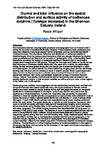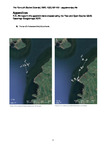Diurnal and tidal influence on the spatial distribution and surface activity of bottlenose dolphins (Tursiops truncatus) in the Shannon Estuary, Ireland
| dc.contributor.author | Wilson, R. | |
| dc.date.accessioned | 2022-12-23T19:53:50Z | |
| dc.date.available | 2022-12-23T19:53:50Z | |
| dc.date.issued | 2022 | |
| dc.identifier.citation |
Wilson, R. (2022) 'Diurnal and tidal influence on the spatial distribution and surface activity of bottlenose dolphins (Tursiops truncatus) in the Shannon Estuary, Ireland', The Plymouth Student Scientist, 15(2), pp.102-126. | en_US |
| dc.identifier.issn | 1754-2383 | |
| dc.identifier.uri | http://hdl.handle.net/10026.1/20120 | |
| dc.description.abstract |
The interactions between oceanographic processes and topography have an important role in driving the formation of localised biodiversity hotspots. These hotspots create predictable prey resources utilised by many large coastal marine vertebrates, such as the bottlenose dolphin Tursiops truncatus. The abundance, behaviour and distribution of bottlenose dolphins is therefore largely driven by predator-prey interactions which are strongly influenced by physical ocean processes such as tides and the formation of hydrographic fronts. Understanding these interactions as well as the ecology of bottlenose dolphins is therefore vital for the effective conservation management of this species. Through the fine scale examination of the diurnal and tidal influences on bottlenose dolphin distribution, this paper aims to define the relationships driving the tidal temporal spatial distribution and habitat use of bottlenose dolphins in a tidally dominated system, as well as identify the drivers behind key foraging areas and the relationship between tidal influence and the direction of travel of dolphin schools. Shore-based observation data of dolphin surface activity were collected using a surveyor’s theodolite from June to September 1996 and 1997 during standardised, systematic surveys of the lower Shannon Estuary, Ireland. Data relating to school position and surface activity were recorded to map species distribution relative to tidal temporal variables, as well as activity in order to infer regions of key habitat use for this species. Observed surface activities were categorised and the relationships between them and tidal and temporal influences were tested statistically using Chi square analyses in RStudio. Kernel density plots were created to visually analyse diurnal and tidal phase influences on the spatial distribution of bottlenose dolphins in this region, and a 2-way ANOVA was used to test the significance of these interactions. Furthermore, focal follow data containing the sequential positions of observed dolphin schools and associated surface activities were collected in order to assess the extent of tidally mediated spatial distribution and direction of travel of schools within this region. A total of 529 dolphin schools were recorded during 55 shore-watches conducted within this study period. The spatial distribution of dolphin schools throughout the estuary were found to be both temporally and tidally mediated with concentrated foraging activity occurring almost exclusively during flooding tides, in the evening period and in mainly upper river regions with steep topography. Two critical foraging locations were identified within the study area: (1) Kilcredaun Point and (2) Beal Strand. The direction of travel of observed dolphin schools was not found to be significantly tidally mediated, though schools were observed to travel at greater frequencies against ebbing tidal flow, and with flooding tides. Tidally mediated spatial distribution was identified to be likely due to the interactions between tidal flow and the topography of the Shannon Estuary, resulting in the formation of hydrographic fronts and regions of intensified current velocities, utilised by the resident population of bottlenose dolphins for enhanced foraging efficiency. The identification of critical foraging locations for bottlenose dolphins in this region of the estuary highlights the importance for the protection of this region and further conservation of its resident populations. | en_US |
| dc.language.iso | en | en_US |
| dc.publisher | University of Plymouth | en_US |
| dc.rights | Attribution 3.0 United States | * |
| dc.rights.uri | http://creativecommons.org/licenses/by/3.0/us/ | * |
| dc.subject | behaviour | en_US |
| dc.subject | distribution | en_US |
| dc.subject | movements, | en_US |
| dc.subject | conservation | en_US |
| dc.subject | oceanographic-topographic interactions | en_US |
| dc.subject | foraging | en_US |
| dc.subject | Tursiops truncatus | en_US |
| dc.title | Diurnal and tidal influence on the spatial distribution and surface activity of bottlenose dolphins (Tursiops truncatus) in the Shannon Estuary, Ireland | en_US |
| dc.type | Article | en_US |
| plymouth.issue | 2 | |
| plymouth.volume | 15 |




